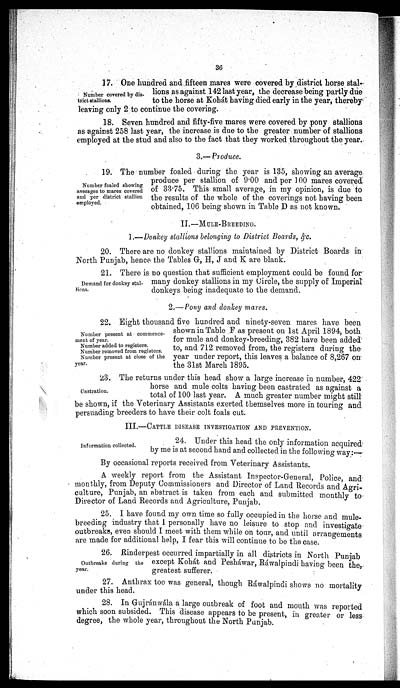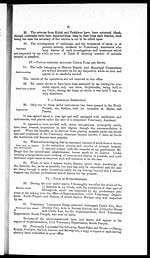Medicine - Veterinary > Civil Veterinary Departments > 1894-1932 - Annual report of the Punjab Veterinary College and of the Civil Veterinary Department, Punjab > 1894-1908 > 1894-1895 - Provincial report of the Civil Veterinary Department Punjab, for the year 1894-95
(46) Page 36
Download files
Individual page:
Thumbnail gallery: Grid view | List view

36
Number covered by dis-
trict stallions.
17. One hundred and fifteen mares were covered by district horse stal-
lions as against 142 last year, the decrease being partly due
to the horse at Kohát having died early in the year, thereby
leaving only 2 to continue the covering.
18. Seven hundred and fifty-five mares were covered by pony stallions
as against 258 last year, the increase is due to the greater number of stallions
employed at the stud and also to the fact that they worked throughout the year.
3.—Produce.
Number foaled showing
averages to mares covered
and per district stallion
employed.
19. The number foaled during the year is 135, showing an average
produce per stallion of 9.00 and per 100 mares covered
of 33.75. This small average, in my opinion, is due to
the results of the whole of the coverings not having been
obtained, 106 being shown in Table D as not known.
II.—MULE-BREEDING.
1.—Donkey stallions belonging to District Boards, &c.
20. There are no donkey stallions maintained by District Boards in
North Punjab, hence the Tables G, H, J and K are blank.
Demand for donkey stal-
lions.
21. There is no question that sufficient employment could be found for
many donkey stallions in my Circle, the supply of Imperial
donkeys being inadequate to the demand.
2.— Pony and donkey mares.
Number present at commence-
ment of year.
Number added to registers.
Number removed from registers.
Number present at close of the
year.
22. Eight thousand five hundred and ninety-seven mares have been
shown in Table F as present on 1st April 1894, both
for mule and donkey-breeding, 382 have been added
to, and 712 removed from, the registers during the
year under report, this leaves a balance of 8,267 on
the 31st March 1895.
Castration.
23. The returns under this head show a large increase in number, 422
horse and mule colts having been castrated as against a
total of 100 last year. A much greater number might still
be shown, if the Veterinary Assistants exerted themselves more in touring and
persuading breeders to have their colt foals cut.
III.— CATTLE DISEASE INVESTIGATION AND PREVENTION.
Information collected.
24. Under this head the only information acquired
by me is at second hand and collected in the following way:—
By occasional reports received from Veterinary Assistants.
A weekly report from the Assistant Inspector-General, Police, and
monthly, from Deputy Commissioners and Director of Land Records and Agri-
culture, Punjab, an abstract is taken from each and submitted monthly to
Director of Land Records and Agriculture, Punjab.
25. I have found my own time so fully occupied in the horse and mule-
breeding industry that I personally have no leisure to stop and investigate
outbreaks, even should I meet with them while on tour, and until arrangements
are made for additional help, I fear this will continue to be the case.
Outbreaks during the
year.
26. Rinderpest occurred impartially in all districts in North Punjab
except Kohát and Pesháwar, Ráwalpindi having been the -
greatest sufferer.
27. Anthrax too was general, though Ráwalpindi shows no mortality
under this head.
28. In Gujránwála a large outbreak of foot and mouth was reported
which soon subsided. This disease appears to be present, in greater or less
degree, the whole year, throughout the North Punjab.
Set display mode to: Large image | Zoom image | Transcription
Images and transcriptions on this page, including medium image downloads, may be used under the Creative Commons Attribution 4.0 International Licence unless otherwise stated. ![]()
| Permanent URL | https://digital.nls.uk/75528227 |
|---|
| Additional NLS resources: | |
|---|---|




